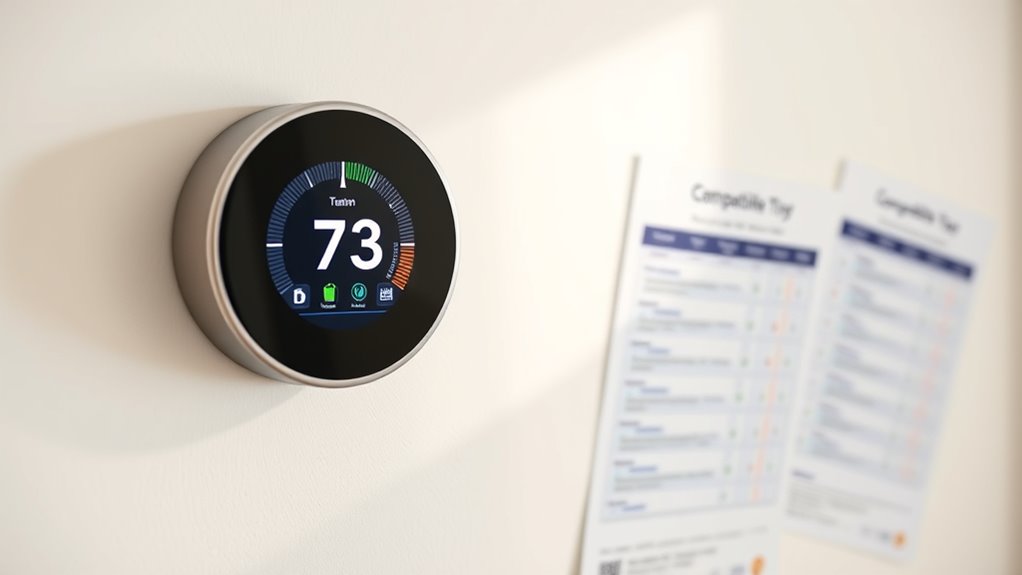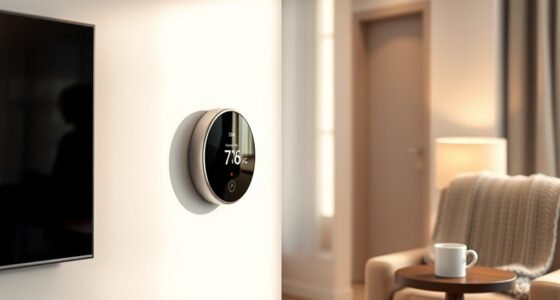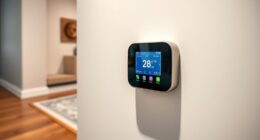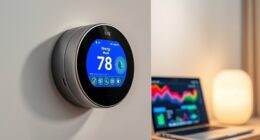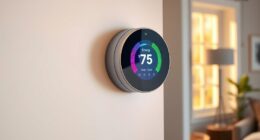To understand smart thermostat compatibility checks, you’ll need to identify your current heating and cooling systems, wiring setup, and power sources. Check if your system is compatible with smart features like voice control or energy savings. Confirm your wiring, especially the C-wire, matches the thermostat’s requirements. Compatibility also depends on your system’s voltage and communication protocols. Keep investigating these factors, and you’ll discover how to select the best options for your home.
Key Takeaways
- Verify the thermostat’s wiring requirements and ensure your existing wiring matches, especially the presence of a C-wire for power.
- Confirm compatibility with your HVAC system type, such as central AC, heat pump, or radiant heating, through manufacturer specifications.
- Check for supported communication protocols (Wi-Fi, Z-Wave, Zigbee) to ensure seamless smart home integration.
- Review supported features like remote sensors, voice control, and automation to match your desired functionalities.
- Ensure firmware standards and open protocols are supported for easier setup and future updates.
Types of Heating and Cooling Systems
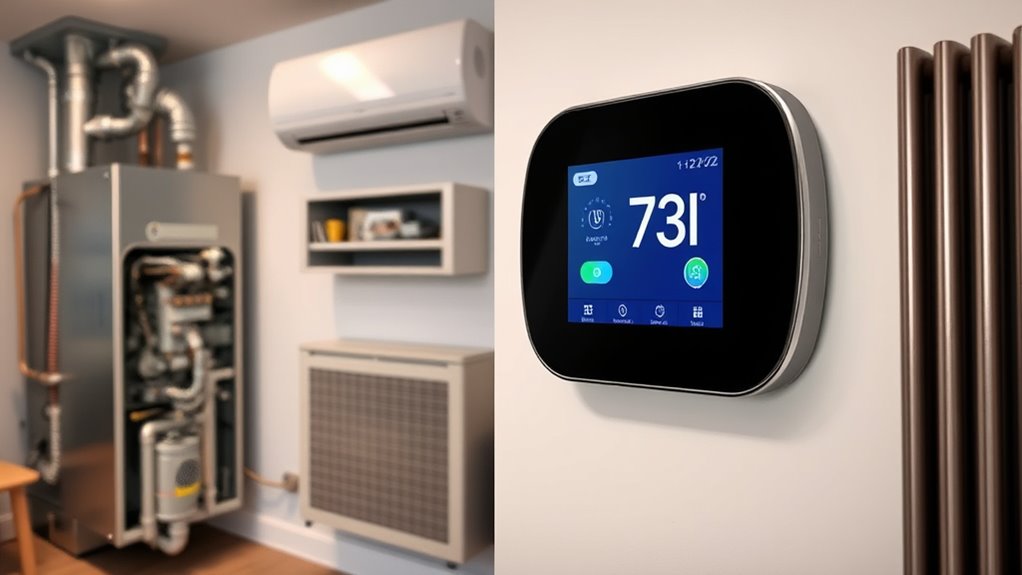
Understanding your heating and cooling system is essential when choosing a smart thermostat, as compatibility depends on the type you have. If you have a geothermal system, you’ll need a thermostat that can connect with its unique underground heat exchange process, which helps regulate temperature efficiently. Radiant heating, which warms floors or walls, also requires a compatible thermostat that can control embedded heating elements precisely. Not all smart thermostats support these advanced systems, so verifying compatibility is vital. For geothermal setups, look for thermostats specifically designed for such systems. Similarly, with radiant heating, ensure the device can handle low-voltage signals or specialized wiring. Knowing your system type helps you select a smart thermostat that functions seamlessly and maximizes your home’s comfort. Additionally, understanding system compatibility ensures you choose a device that can support your specific heating or cooling technology without issues. Being aware of your existing system type can prevent costly installation problems and ensure your smart thermostat works effectively from the start. Moreover, considering the system configuration can aid in selecting a thermostat that integrates smoothly with your home’s overall HVAC setup.
Identifying Your Current Thermostat Type
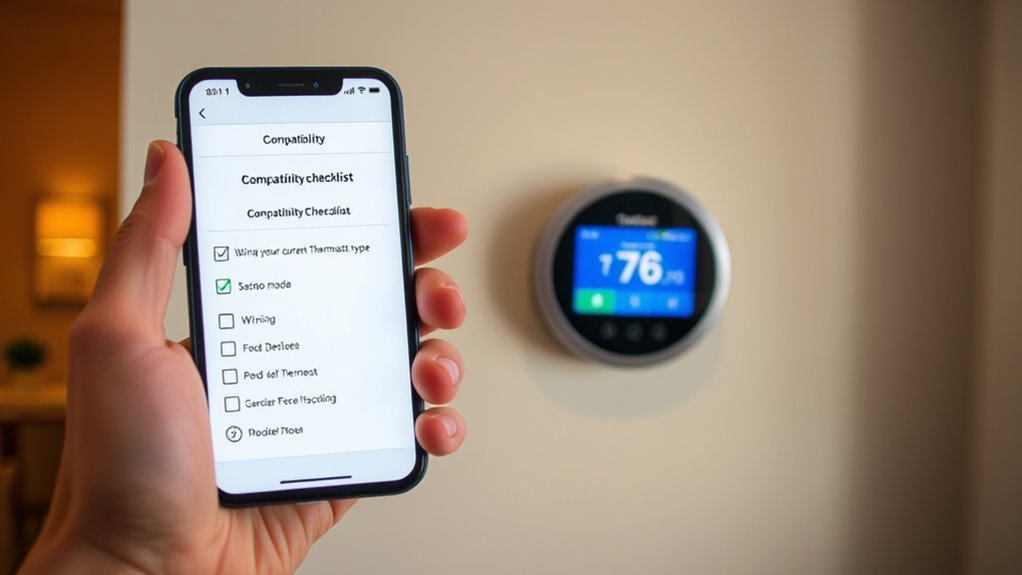
To identify your current thermostat type, start by checking its model number or brand. Decide if it’s wired or wireless, as this affects compatibility options. Look for compatibility indicators or connection types to determine which smart thermostats will work with your setup. Additionally, understanding the connection types used in your thermostat can help ensure proper integration with smart devices. For example, knowing whether your thermostat uses digital or analog signals can influence compatible options and setup procedures. Being aware of the necessary cookies involved in your device’s operation can also assist in troubleshooting potential integration issues.
Existing Thermostat Models
Before exploring compatible smart thermostats, you need to identify your current thermostat model. Check if your thermostat supports remote sensor integration, which allows you to add sensors for better zone control. Some models also feature voice control features, making it easier to adjust settings hands-free. Look at the thermostat’s display or user manual to determine its capabilities. If it’s a basic model with no smart features, upgrading might be necessary for compatibility. Modern thermostats often have Wi-Fi connectivity, enabling remote access and integration with voice assistants. Knowing your current model helps you decide whether you need a simple upgrade or a more advanced system that supports remote sensors and voice control features. Additionally, understanding your thermostat’s compatibility with environmental features can enhance your home environment. This step facilitates a smooth transition to a smarter home climate system, especially as security considerations become more integrated into home automation.
Wired vs. Wireless
Start by determining whether your thermostat is wired or wireless, as this affects compatibility with smart thermostats. Wired thermostats connect directly to your HVAC system through physical wires, making installation procedures straightforward but sometimes more involved. Wireless thermostats use wireless protocols like Wi-Fi, Zigbee, or Z-Wave to communicate with your heating and cooling system, offering easier installation and more flexible placement. To identify your current setup, check if your thermostat is physically connected to wires or if it operates via a wireless signal. Knowing this helps you choose a compatible smart thermostat and understand whether you’ll need additional adapters or hubs. This initial step guarantees a smooth upgrade process and prevents compatibility issues later on. Additionally, understanding the market growth in AI tech indicates that smart home devices are increasingly sophisticated, which can influence your choice of features and integration options. Being aware of the different communication protocols can help you select a device that seamlessly integrates with your existing smart home ecosystem.
Compatibility Indicators
Determining your current thermostat type involves examining how it connects to your HVAC system. Look at the wiring and note the number of wires; a standard two-wire system often indicates a basic model, while multiple wires suggest more advanced features. Check the user interface—if you have a simple dial or no display, it’s likely an older, manual thermostat. Modern thermostats often feature digital screens with touch controls, supporting energy efficiency by providing detailed scheduling options. Additionally, some thermostats connect wirelessly, identifiable by their lack of physical wiring or a Wi-Fi indicator. Understanding these compatibility indicators helps you assess whether your current thermostat supports smart features or if an upgrade is necessary for better energy management and user experience. Incorporating quality assurance practices, like verifying compatibility before installation, can prevent potential issues and ensure a smooth upgrade process. Being aware of smart home integration options can further enhance your home’s automation capabilities and overall convenience. Remote work lifestyle habits, such as adjusting your thermostat for comfort and efficiency, can also play a role in overall home productivity and energy savings.
Compatibility With Heating Systems
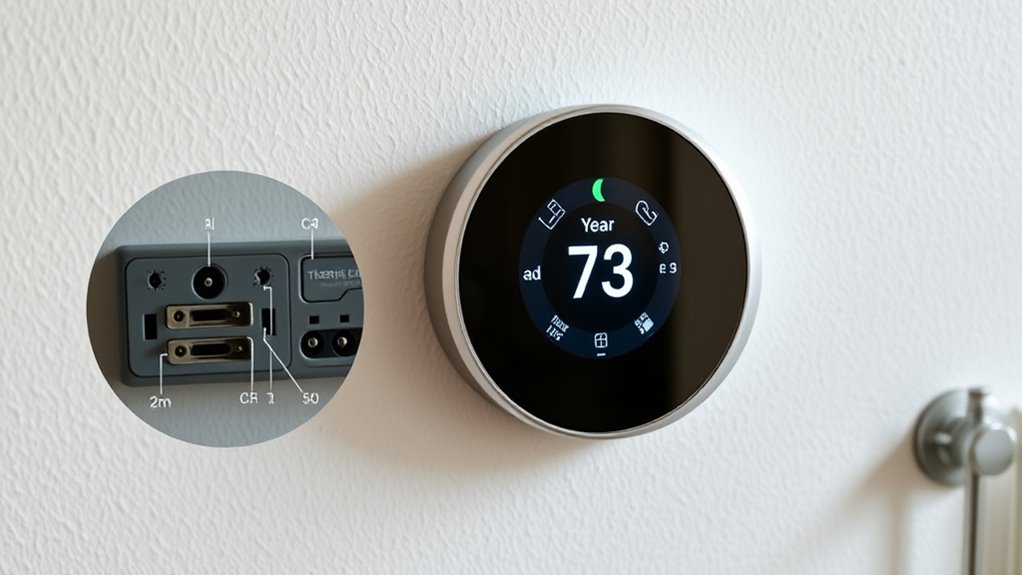
Smart thermostats are designed to work with a variety of heating systems, but their compatibility depends on the type and configuration of your setup. You need to check if your system supports common communication protocols and wiring requirements. For example, some models require a C-wire for power, which influences installation location and wiring complexity. Additionally, consider the programming language of the thermostat’s firmware—some rely on open standards, making integration easier. Being aware of automation technologies can help you understand how your thermostat interacts with other smart home devices. It’s also important to verify that your heating system uses compatible wiring and control signals, ensuring seamless operation and proper functionality. Verify the installation location allows for proper sensor placement and accessibility. Confirm the thermostat’s firmware supports your system’s communication protocol for seamless operation. Understanding headphone jacks can also be helpful if you plan to use audio alerts or notifications with your smart thermostat setup.
Compatibility With Cooling Systems
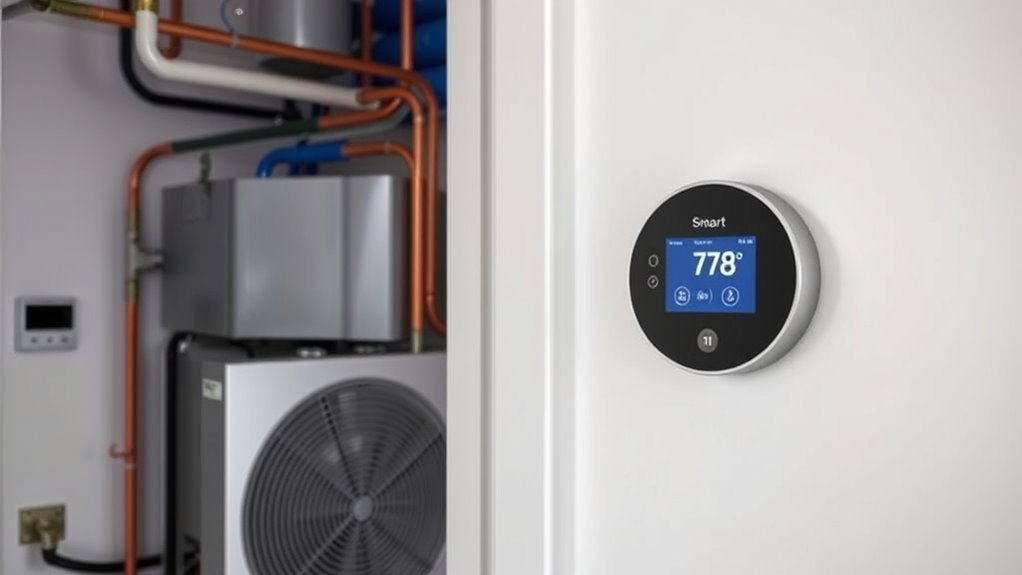
Your cooling system type determines which smart thermostats will work best for you. Some systems, like central AC units, are straightforward, while others, such as ductless minisplits, may need special features. Make certain your wiring matches the thermostat’s requirements to ensure proper installation and operation. Properly GMC tuning can also enhance your system’s efficiency and responsiveness. Additionally, verifying system compatibility before installation can prevent potential issues and ensure seamless integration with your existing setup.
Cooling System Types
Different cooling system types require specific thermostat compatibilities to guarantee ideal performance. Knowing your system ensures you can do a DIY installation smoothly and maximize energy savings. For example, central air, ductless mini-splits, and heat pumps each need compatible thermostats to work efficiently. Additionally, understanding home decoration inspiration can help you choose smart thermostats that blend seamlessly with your interior design. Recognizing cooling system compatibility can prevent costly errors and ensure your system operates as intended. Matching your cooling system type with the right smart thermostat helps you save energy and avoid compatibility issues. Always verify your system’s specifications before purchasing. Incorporating smart home integration features can further enhance control and energy management.
Wiring Requirements
Wiring requirements are essential for guaranteeing that your thermostat integrates seamlessly with your cooling system. Proper wiring guarantees reliable operation and smooth communication, especially if your thermostat features wireless connectivity and a user interface. Before installation, verify that your system’s wiring matches the thermostat’s specifications. Some models require common (C) wires for continuous power, while others may work without them. Ensuring correct wiring supports advanced features like remote control via wireless connectivity and easy navigation through the user interface.
| Wiring Type | Compatibility Notes | Importance |
|---|---|---|
| C-wire needed | Essential for power, supports features | Ensures consistent operation |
| No C-wire | May require alternative power sources | Check compatibility before installation |
| Wireless | Requires proper wiring for reliable signals | Facilitates seamless connectivity |
Electrical Wiring Requirements
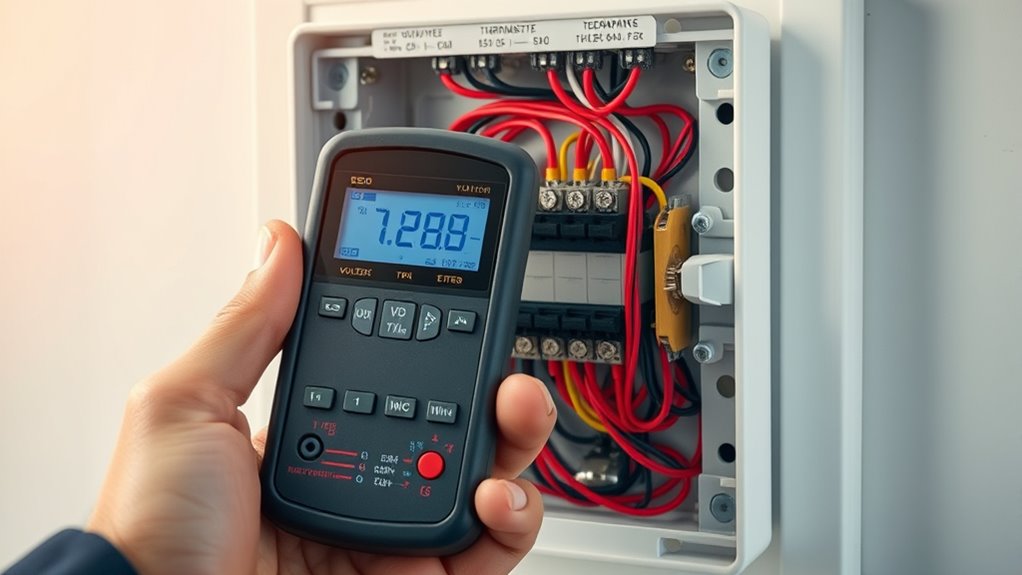
To guarantee your smart thermostat functions properly, it’s essential to understand the electrical wiring requirements. Making certain proper wiring helps with wireless installation and confirms voltage compatibility with your home’s system. Check if your existing wires support the necessary voltages, typically 24V for most thermostats. If your system uses high-voltage wiring, you might need an adapter or professional help. Proper wiring also involves verifying the terminal connections and avoiding loose or damaged wires that can disrupt operation. Additionally, be aware that improper wiring can lead to increased energy consumption and reduced system efficiency. Ensuring your wiring setup is correct can also prevent potential fire hazards and system malfunctions. Recognizing trust issues within your electrical connections can prevent future troubleshooting problems.
Power Source Considerations
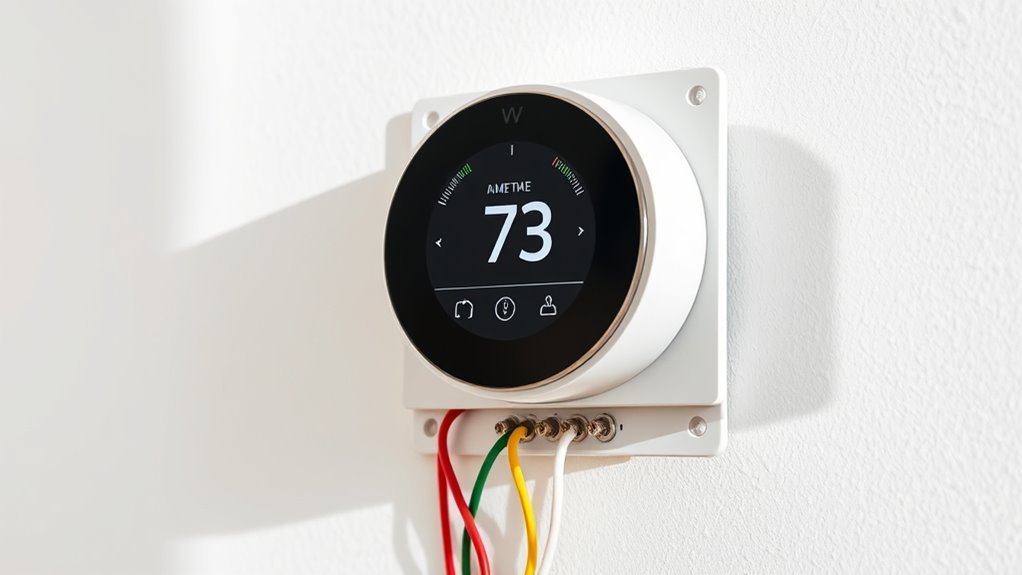
Ensuring your smart thermostat has the appropriate power source is key to reliable operation. You need to consider whether your device relies on wired power, wireless power, or batteries. Wireless power options, like solar or inductive charging, can reduce wiring needs but may require specific compatibility with your thermostat model. Battery compatibility is also vital; some thermostats use rechargeable or standard batteries, offering flexibility in installation. Check if your thermostat supports battery backup in case of power outages, ensuring continuous operation. If your home’s wiring isn’t compatible with your chosen device, or if you prefer a wireless setup, verify that your thermostat can handle these power sources without losing functionality. Correct power source compatibility guarantees your smart thermostat performs consistently and efficiently.
Smart Thermostat Features and Compatibility

Understanding the features and compatibility of a smart thermostat is essential to guarantee it meets your home’s needs. You’ll want to ensure it supports key functions like voice control, which allows you to adjust settings hands-free, and energy savings, helping reduce utility bills. Compatibility with your existing HVAC system determines if the thermostat will work smoothly without extra upgrades. Some features to consider include smart scheduling, remote access via apps, and learning algorithms that adapt to your routines.
Ensuring your smart thermostat supports voice control, energy savings, and HVAC compatibility guarantees seamless integration and optimal home comfort.
- Compatibility with voice assistants like Alexa or Google Assistant
- Support for various HVAC systems, including heat pumps and multi-stage heating
- Integration with energy-saving modes and sensors for optimized performance
Using Compatibility Check Tools and Resources

Using compatibility check tools and resources can streamline your process of selecting the right smart thermostat for your home. These tools help you quickly determine if your existing HVAC system supports specific models, saving you time and frustration. They often include filters for energy efficiency features, so you can prioritize thermostats that reduce your energy consumption. Additionally, many resources provide insights into the user interface, ensuring you choose a device with an intuitive design that’s easy to operate. Online compatibility checkers are user-friendly and offer step-by-step guidance, making the process straightforward. By leveraging these tools, you can confidently select a smart thermostat that fits your system, enhances energy efficiency, and features a user interface that suits your preferences.
Troubleshooting Common Compatibility Issues
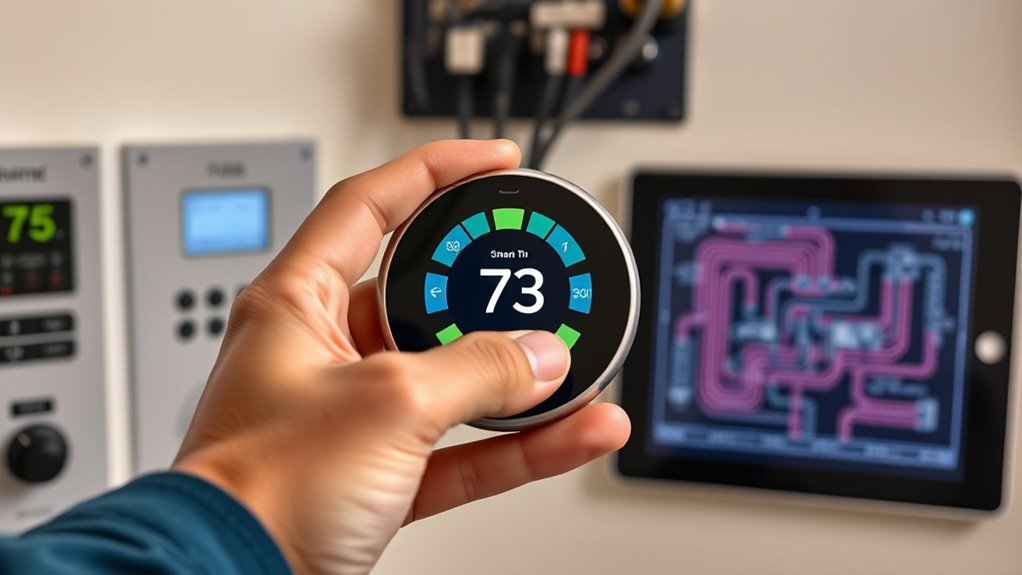
When your smart thermostat isn’t compatible with your HVAC system, troubleshooting begins by verifying the model’s specifications against your existing setup. Check your system’s wiring, age, and type to guarantee they meet the thermostat’s requirements. Sometimes, compatibility issues stem from outdated systems or incompatible wiring, which can hinder energy efficiency and disrupt proper installation. To resolve these problems, consult detailed installation guides and compatibility charts provided by manufacturers. Additionally, consider the following:
- Confirm if your HVAC system supports the thermostat’s communication protocols (e.g., Wi-Fi, Z-Wave).
- Ensure your system’s voltage matches the thermostat’s specifications.
- Verify that your HVAC system’s age and type align with the thermostat’s recommended models.
Addressing these points helps optimize energy efficiency and smooth installation.
Frequently Asked Questions
Can I Install a Smart Thermostat Without Professional Help?
You can definitely try DIY installation of a smart thermostat, but it depends on your comfort with electrical work and your home’s wiring. Make sure to follow the manufacturer’s instructions carefully. Compatibility troubleshooting is key—you need to verify your HVAC system works with the thermostat. If you’re unsure or encounter issues, consulting a professional can save you time and prevent potential problems. Always prioritize safety and proper setup.
Are Smart Thermostats Compatible With Solar-Powered Heating Systems?
You might think solar-powered heating systems are a perfect match for smart thermostats, but solar compatibility and electrical requirements can complicate things. These systems often have unique power sources or wiring setups that might not align with standard smart thermostat specs. Before installing, check if your thermostat supports solar compatibility or if additional wiring or adapters are needed. Ensuring electrical requirements are met keeps your system running smoothly and efficiently.
How Do I Update My Existing Thermostat to a Smart Version?
To update your existing thermostat to a smart version, start with DIY installation if you’re comfortable with wiring. Turn off power, remove your old thermostat, and follow the manufacturer’s instructions for the new device. Before connecting, perform compatibility testing to guarantee it works with your HVAC system. Once everything checks out, connect the wires, turn the power back on, and configure your smart thermostat through its app for remote control.
Do Smart Thermostats Work With Multi-Zone HVAC Systems?
Yes, smart thermostats do work with multi-zone HVAC systems. You just need to guarantee multi-zone compatibility and proper HVAC integration. Check if your system supports multiple thermostats or zone controls, and select a smart thermostat compatible with your setup. Proper installation and configuration allow you to control each zone independently, improving energy efficiency and comfort. Always review your HVAC system’s specifications and consult with a professional if needed.
Are There Privacy Concerns With Smart Thermostat Data Collection?
Imagine your smart thermostat as a cautious friend who takes notes on your routines. While this data collection helps optimize your comfort, it also raises privacy concerns. You might worry about who accesses your personal information or how it’s used. Be aware that some smart thermostats transmit data to third parties, so understanding privacy policies is essential to keep your home secure and your habits private.
Conclusion
By understanding these compatibility checks, you’re opening the secret to transforming your home into a futuristic haven. Imagine never worrying about heating or cooling issues again—your smart thermostat seamlessly working with your system, saving you countless hours and headaches. Don’t settle for less; embrace the power of perfect compatibility and turn your home into the ultimate comfort zone. The future of home comfort is in your hands—make sure your thermostat is ready for the revolution!
